Exploring the Use of AI in Automotive Industry: Stats, Hot Trends & Shocking Innovations
With the rapid evolution of artificial intelligence (AI), the use of AI in automotive industry is rather a logical trait than an unexpected transformation. Hear me out: the use of AI in automotive industry has a compound annual growth rate (CAGR) of 42.8% between 2025 and 2034. Nearly +50% for less than a decade? Sounds crazy, doesn't it? Yet, researchers claim this is only the beginning of a whole new era. So, what is waiting for us just around the corner? Personally, I would be really impressed by flying cars. But let's leave my childish dreams aside and get straight to the core. From automotive intelligence and AI-based dealership management systems (DMS) to advanced driver-assistance systems (ADAS) and V2V & V2I communication, the use of AI in automotive industry definitely has something to offer (and impress, as well). Ready, set... Let's crush the use of AI in automotive together!
To sum up, here are several interesting topics we will discuss today:
- The definition, history, and essential role of the use of AI in automotive industry.
- The use of AI in the automotive industry is imperative since it not only empowers smart use of vehicles but also contributes to enhanced safety, efficiency, and overall automotive market growth and innovation.
- The key advantages of the use of AI in automotive industry include optimized safety, driver experience, supply chain management, environmental friendliness, cost efficiency, manufacturing QC, predictive maintenance, and automotive learning, to name a few.
- The top 3 uses of AI in automotive industry include AI DMS systems, AI ADAS solutions, and V2V/V2I communication.
- AI DMS — unique platforms that provide enhanced data-driven outcomes in terms of decision-making, routine processes, analytics, and customer engagement.
- AI ADAS — specific sensor-driven and algorithm-enhanced driver assistance systems.
- V2V — a direct wireless communication paradigm between several vehicles.
- V2C — a roadside Unit (RSU) communication paradigm between a particular vehicle and roadside infrastructure.
- Automotive software development services delivered by our expert team: connected vehicle technology, automotive cloud solutions, ML, AI, and computer vision, and enterprise mobility solutions.

- What Is the use of AI in the Automotive Industry?
- The History of AI in Automotive Industry
- Why Is AI Important in Automotive?
- What Are the Benefits of Using AI in Vehicles?
- The Top 4 Exclusive Benefits of Using AI in Vehicles
- How Is AI Used in Cars?
- The Use of AI in Automotive Industry: Vehicle Maintenance App Development
- Why Entrust AI-Powered Automotive Software Development to Devabit?
- Quick Summary on the Use of AI in Automotive Industry
What Is AI in the Automotive Industry?
The use of AI in the automotive industry is the process of using artificial intelligence (AI) and related technology to improve, innovate, and support vehicles:
- design;
- manufacturing;
- operation;
- ownership.
The automotive industry, in turn, stands for different types of motor vehicles, including:
- cars;
- trucks;
- motorcycles.

The History of AI in Automotive Industry
Below, we gathered the key events in the history of AI in automotive industry that have shaped the current state of AI vehicle technology:
- 1939 — the first experiments dedicated to self-driving cars.
- 1950s — Alan Turing introduced the idea of AI during his Turing test.
- 1978 — an assembly line robotic arm SCARA was developed for manufacturing.
- 1980s — the first self-sufficient and truly autonomous vehicle.
- 1990s — the rise of AI and machine learning (ML) in manufacturing.
- 2004 — the Defense Advanced Research Projects Agency (DARPA) offered a $1 million prize to robotic engineers capable of creating an autonomous vehicle that can finish a 150-mile route in the Mojave Desert.
- 2009 — Google introduced a driverless car (secretly).
- 2010s — automotive leaders like Ford, Volkswagen, Mercedes-Benz, Nissan, BMW, General Motors, Toyota, Volvo, and Audi invested in testing driverless vehicle systems.
- 2020s — multiple regulations to control the use of AI in automotive and driverless car technology.
What is next? Apart from driverless technology, the 2020s are associated with a robust spike in automotive AI innovations like AI-based DMS, ADAS, IoT, built-in AI car assistants, and cobots, to name a few.
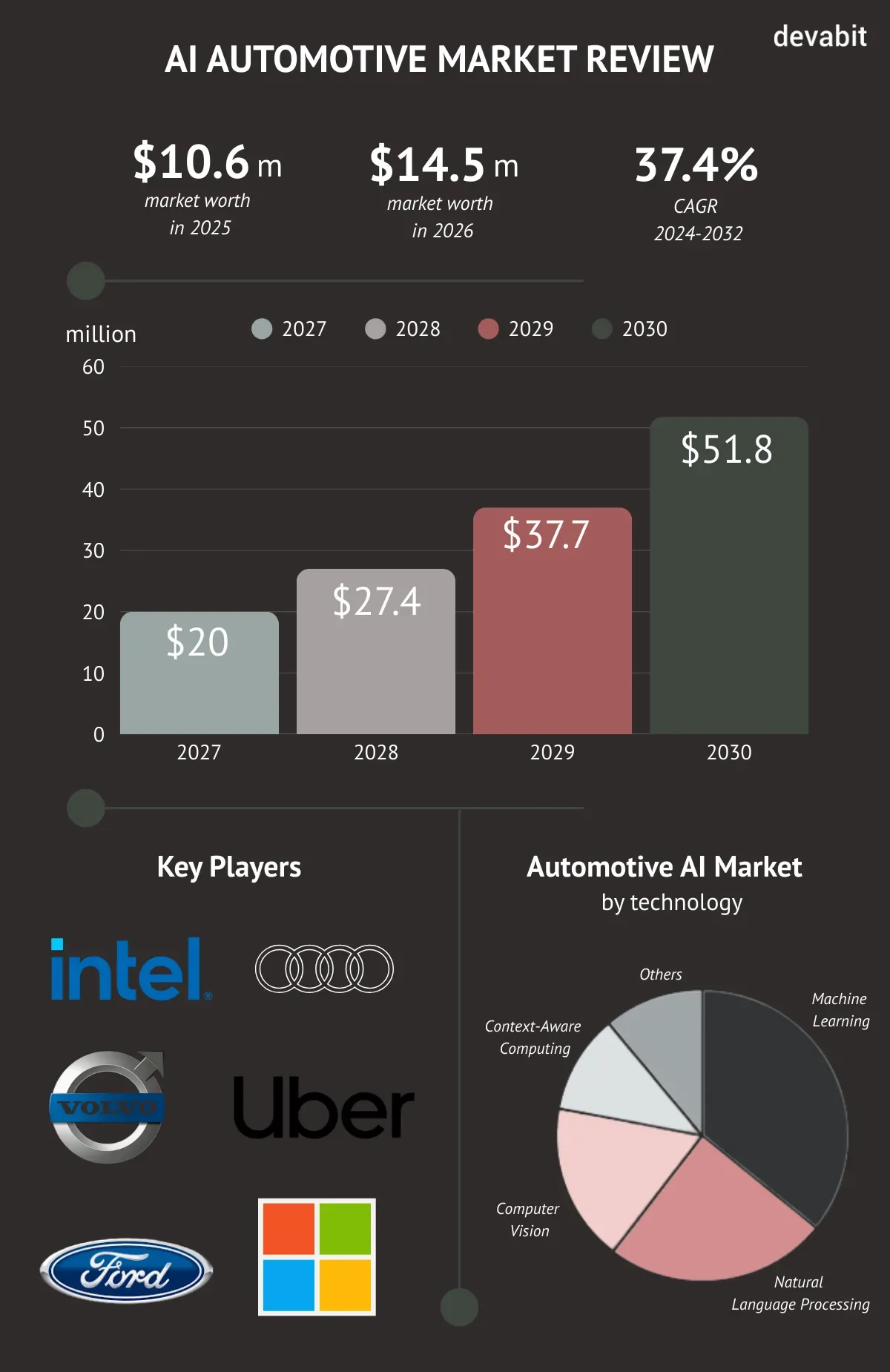
Why Is AI Important in Automotive?
The importance of the use of AI in automotive industry can be easily measured by 5 key categories:
- Smart use of vehicles.
- Unparalleled safety.
- Enhanced efficiency.
- Connected technology.
- Constant innovation.
Now, let's take a look at each of these aspects in detail:
- Smart use of vehicles refers to utilizing cars, trucks, and motorcycles with minimum human effort and environmental harm. By way of illustration, driverless vehicles, which heavily rely on AI in terms of operations, eliminate manual driving while utilizing electricity (a more environmentally friendly option) instead of fuel and gas.
- Unparalleled safety is imperative to the importance of the use of AI in automotive industry since it is achieved by leveraging AI technology to minimize human error, monitor external impacts, and enhance production efficiency in vehicle manufacturing and the subsequent use of cars, motorcycles, and trucks. Just to add more clarity: nearly 50% of automobile owners consider that AI will make driving safer (and this number is constantly growing).
- Enhanced efficiency provided by AI analytical capabilities contributes to faster automotive manufacturing, optimized vehicle maintenance, and a higher rate of driver/passenger satisfaction.
- Connected technology serves as an illustrative sign of the importance of AI in automotive industry by enabling the use of half-autonomous vehicles in countries that banned the usage of driverless cars (China, British Columbia, and Australia). How does it work? When AI is integrated into connected vehicle technology, it just assists drivers instead of completely replacing them.
- Constant innovation in the areas of car dealership and agentic AI vehicle maintenance systems is something we already see in 2026, and researchers claim this tendency is not going to end during the following decade. While the use of AI in the automotive industry evolves at a rapid pace (with 70%(!) of car owners already willing to use an AI agent to diagnose vehicle issues in real time), AI appears to be one of the most powerful drivers of the automotive industry's growth.

Summing up, why is AI important in automotive industry? Just look at numbers, they always speak louder than words:
- The global automotive CAGR during 2005-2015 is 3.08%.
- The global automotive CAGR during 2015-2025 is 3.5%.
- The global automotive CAGR during 2025-2035 is expected to reach 5.66%.
Such an aggressive spike in future forecasts proves that the use of AI in automotive industry has a positive impact on the global vehicle ecosystem.
Talking about the positive impact, it is the perfect time to mention a few more automotive industry tendencies taking the leadership positions among the vehicle manufacturers and automotive software developers.
Edge AI — the game-changer that is shaping the future of the automotive industry, or a smart mobility miracle that we can observe not tomorrow, but today.
Simply put, Edge AI deploys AI algorithms on local devices (e.g., sensors, IoT devices, etc.) to enable real-time processing. Over and above that, edge AI does not rely on cloud infrastructure. And what does it mean for the automotive industry? Do we use Edgr AI in cars? Can Edge AI software contribute to road safety? Are autonomous driving and Edge AI assistants the same thing? What are the latest automotive Edge AI trends? Does Edge AI contribute to personalized driving experiences?
So many questions lack clear answers. Find them all in one place right below!
What Are the Benefits of Using AI in Vehicles?
From design and manufacturing to sales and usage, the use of AI in automotive industry encompasses all stages of vehicle production and execution. Yet, how did the use of AI in automotive industry become so popular? Well, the actual grail of truth lies in the multiple advantages the use of AI brings to the automotive industry. Let's start with defining the fundamental benefits of using AI in vehicles:
- Next-Gen Safety: With AI, driving experience is safer than it would be with a human driver, even a skilled one. Monitoring behavior, tracking external impacts, and constantly performing tech checks — the use of AI in automotive industry combines various essential practices aimed at achieving one common goal: ensuring the 99.9% safety of drivers, passengers, and people involved in vehicle manufacturing.
- Optimized Driving Experience: From selecting the best route with the lightest traffic to predicting dangerous weather conditions based on location and temperature outside of a car, the capabilities of AI in the automotive industry go far beyond the traditional understanding of a comfortable journey.
- Environmental Benefit: Did you know that AI can help reduce greenhouse gas emissions? Wait, what? Let's quickly explain how it works. According to the study "Autonomous electric vehicles can reduce carbon emissions and air pollution in cities" by Tolga E., Nuri C., Onat C., and others, driverless cars can reduce fuel and carbon emissions by up to 34% of the total emissions from vehicles by 2050.
Taking a quick step aside from the Agentic AI benefits, we cannot miss the opportunity to mention the power of Edge AI and its role in the automotive industry and, in particular, smart mobility.
And in case Edge AI in smart mobility seems like a completely unknown road ahead for you, devabit has prepared the most straightforward guide map specifically for such cases. And our checkpoints are:
- What is Edge AI Software?
- What is Smart Mobility?
- How can Edge AI Software contribute to vehicle safety?
- What are the key advantages of the Edge AI software in the automotive industry?
- How to eliminate deadly road accidents with Edge AI?
- How do you implement Edge AI software in a vehicle?
Follow the link to find all the answers in plain English and even more smart mobility insights.

- Supply Chain Management: Each vehicle consists of thousands of tiny and large particles, and most of them are produced separately. Such a complex supply chain can be easily interrupted: one part gets lost in the process and everything just stops... Luckily, the use of AI in automotive industry solves this issue. As reported by McKinsey & Company, "early adopters of AI-enabled supply chain management have improved logistics costs by 15%, inventory levels by 35%, and service levels by 65% compared to their competitors." Sounds promising, right? With this in mind, innovation-driven automotive manufacturers invest in smart delivery tracking platforms, enterprise resource planning solutions, and capacity management platforms.
- Cost-Saving Opportunities: AI-driven simulation tools cut prototyping expenses by 25%. Optimized AI routes cut gasoline costs by 20%. AI-based DMS systems have a savings potential of up to $2,000 per automobile per year. And it is just the tip of the iceberg. From design and manufacturing to fuel and repair expenses, the use of AI in automotive industry saves your money every step of the way.
- Manufacturing Quality Control: As we have already sorted out, vehicle manufacturing is a complex process with multiple allied services and potential pitfalls. With industry-specific regulations like ISO 26262, IATF, QMS, and FMVSS, to name a few, the automotive industry stands out as one of the most strictly regulated domains. Capable of detecting even minor defects in the vehicle manufacturing process, AI-powered QC solutions can promptly notify employees, reducing the response-reaction period.
Examples of Agentic AI in the Automotive Industry
Although society perceives Agentic AI as an alien (something innovative that is far from reality), it is already here, in the room with us! Needless to say, Agentic AI in the automotive industry is not just a buzzword — it is a helpful co-pilot you can test right now.
Recently, Mercedes introduced the MBUX Virtual Voice Assistant. It can be triggered by "Hey Mercedes!" while handling up to 20 commands. Sounds impressive, right? Later on, the MBUX collaborated with top AI platforms like Gemini and agentic AI in order to create something truly impressive: a virtual AI-powered assistant that perfectly imitates human interactions, ensuring next-gen experiences for Mercedes drivers.
Another awe-inspiring agentic AI automotive example worth your attention is the vehicle predictive maintenance platform developed by... drum roll... Our automotive software development team! This unique dynamic pricing and capacity management platform is powered by AI and ML technologies. Aimed at streamlining technicians' and clients' workflows, the solution operates within time-slot booking and discounts algorithms. Over and above that, it is integrated with market-leading DMS systems so that it can manage and analyze large amounts of critical automotive data, thereby completely replacing internal ERP and CRM systems.
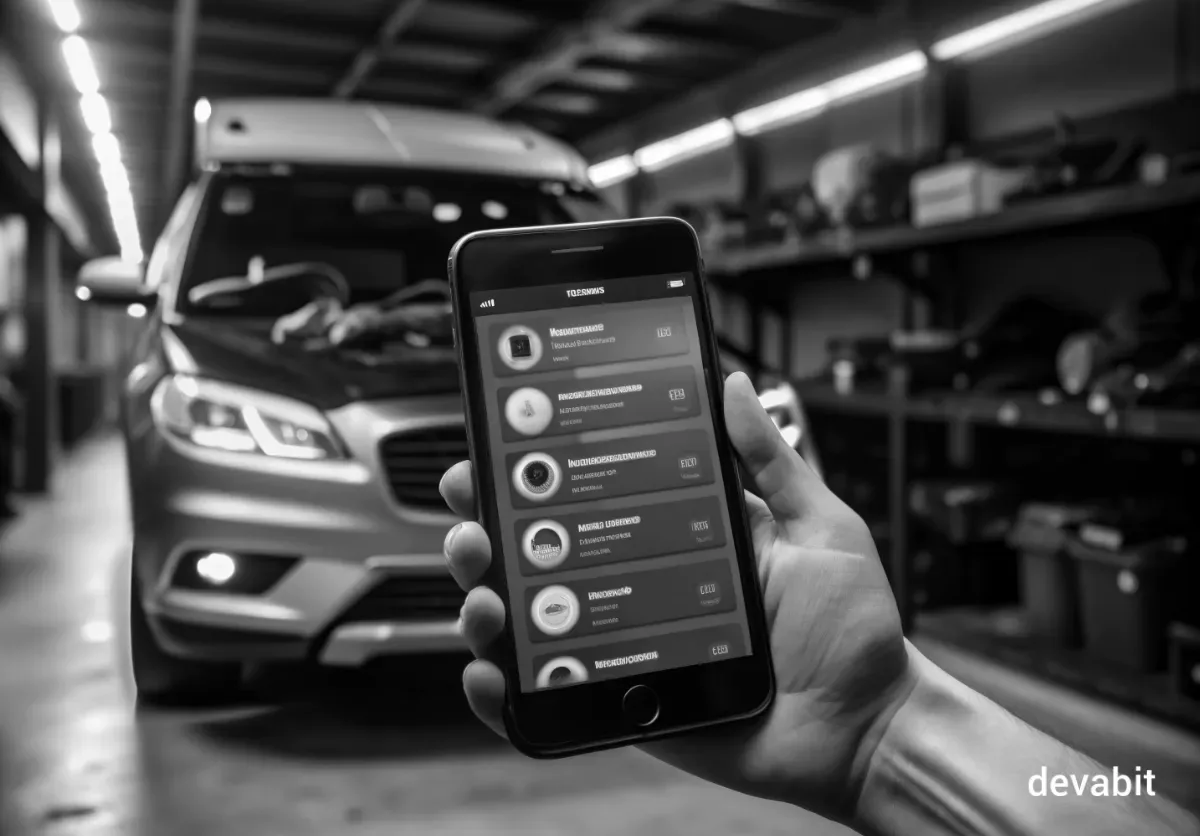
The Top 4 Exclusive Benefits of Using AI in Vehicles
Are there any unique advantages that the use of AI in automotive industry brings to the table? Absolutely! Apart from fundamental benefits related to the use of AI in automotive industry, there are several cutting-edge benefits that will blow your mind. Ready to dive in?
1) Predictive Vehicle Maintenance
Noticed coolant leaks? Forgot to change oil? Feel that misfires and poor engine performance happen way too often? With predictive vehicle maintenance, also known as predictive modeling, you do not have to worry that something will unexpectedly go wrong. So, how does AI predictive vehicle maintenance work? Check this step-by-step guide:
- Collecting Data: First, the system collects data from ultrasonic sensors, camera-based perception, and object detection and tracking technologies.
- Analytical Process: After the sensor fusion procedure, AI analyzes the collected data with the help of Machine Learning (ML) and Agentic AI technologies (Data Annotation/Data Labeling).
- System Alerts & Recommendations: The system decides which issues are worth drivers' attention and notifies them just in time to prevent further damage.
- Proactive Vehicle Maintenance: precise repair recommendations based on the actual condition of the vehicle.
The common issues AI predictive vehicle maintenance can help with:
- detect unusual engine behavior;
- detect engine temperature instabilities;
- detect high tire pressure and temperature; detect battery degradation;
- detect fluid leaks (engine oil/coolant), etc.
Quick statistical proof:
- Nearly 50% of vehicle manufacturers use AI predictive maintenance to save costs.
- The global AI predictive maintenance market in the automotive industry is predicted to hit $191.42 billion by 2032.
- The CAGR of the AI predictive maintenance market is accordingly 18.6% between 2025 and 2032.
How to develop an automotive predictive maintenance solution?
- Phase 1: Discovery.
- Phase 2: Prototyping.
- Phase 3: MVP development.
- Phase 4: Go-live + feature gap fill
- Ongoing maintenance & support.

2) Personalized Driving Experience
Do you prefer the temperature to be warm while driving to work? Maybe your seat should have a specific angle to ensure a comfortable ride? Having an AI assistant by your side is almost like having a childhood friend: it remembers all your preferences to the tiniest details.
Interesting features provided by AI to ensure a personalized driving experience:
- face recognition technology enables specific settings adjusted to a particular driver;
- climate regulation;
- air conditioning mode adjustment;
- routes memory;
- specific seat and mirror positioning;
- personalized entertainment; automatic music on/off modes, etc.
Quick statistical proof:
- 43% of drivers agree to collect and analyze their personal data to get advanced driver personalization.
- Personalized driving experience ensured by the use of AI in automotive industry can lead to a 30% increase in driver satisfaction.
- 70% of R&D decision-makers prioritize personalized driving experience provided by AI during early development stages.

3) Enhanced Automotive Learning
Every driver knows that learning to drive is not an easy challenge. And mistakes can often cost a person's life. Fortunately, the use of AI in automotive industry can ensure a learner's safety while providing a top-notch learning experience. So, how does AI ensure enhanced automotive learning?
- Highly Personalized Approach: AI can tailor learning scenarios to the user's experience, level of knowledge, health specifics, and other individual factors.
- VR & AR Assistants: AI can enable VR and AR simulations when the driver needs specific instructions or assistance.
- Statistical Summary: AI can collect data and provide each learner with personalized analytics based on their performance.
Quick statistical proof:
- 68% of drivers are ready to invest in AI to get clear explanations of car mechanics/features.
- 63% of drivers claim that AI navigation based on personal preferences would be helpful during the learning process.

4) Autonomous Driving
Did you know that AI is the core technology behind the concept of autonomous driving? Whether it is cars with half-autonomous driving technology or fully automated vehicles, AI is the secret power that lets all the magic happen. So, how does AI-enabled autonomous driving work?
- Highly relying on specific algorithms and neural networks, autonomous cars utilize AI and ML for object recognition.
- Such a unique algorithm allows for collecting and analyzing data while making accurate predictions and driving decisions.
Quick statistical proof:
- As reported by Statista, the annual production of autonomous vehicles is expected to reach 800,000 units in 2030.
- According to the Center for Sustainable Systems, vehicle accidents can be reduced up to 90% (!) due to the growing adoption of autonomous cars.

How is AI Used in Cars?
What a time to be alive! Autonomous vehicles, flying cars (ah, sorry, that was not meant to be included, just my dreams jumping out of nowhere again), and AI-powered car maintenance predictions — the AI use of AI in automotime industry has definitely gained momentum in the modern world. Now, let's take a look at the top 3 uses of AI in automotive industry:
1) AI Dealership Management Systems (DMS)
First and foremost, what is an AI dealership management system (DMS)? An AI dealership management system (DMS) is an integrated software solution empowered by ML algorithms and AI predictive analytics capabilities in order to streamline different areas of dealership process, including:
- inventory;
- finance;
- sales;
- service;
- customer relationship management (CRM).

How do AI-empowered DMS solutions differ from traditional DMS platforms?
Apart from fundamental technology differences, AI DMS platforms provide enhanced data-driven outcomes, especially when it comes to decision-making, routine processes, analytics, and customer engagement.
By way of illustration, traditional DMS systems rely solely on descriptive analytics (in other words, describing only the "what happened" side of an issue) and offer static reports with no to minimal customization that require human interpretation for decision-making. Meanwhile, AI DMS platforms utilize predictive analytics in terms of sales forecasting, churn prediction, demand assessment, etc., and prescriptive analytics for recommending optimal actions based on specific scenarios and circumstances (e.g., inventory redistribution). Furthermore, AI DMS solutions offer auto-generated insights through natural language queries (NLQ) and dashboards, enabling continuous model retraining to adapt to ever-changing conditions and seasonal peaks.
The difference in customer engagement is also impressive. AI DMS systems go far beyond the standard CRM capabilities and manual activities, providing enhanced customer clustering (K-means, DBSCAN) for micro-segment targeting. In contrast to mass-targeted "unique" discounts and "personalized" offerings, AI DMS solutions analyze VIN, preferences, history, peak customer hours, and more to provide specific offerings that benefit both customers and service providers.
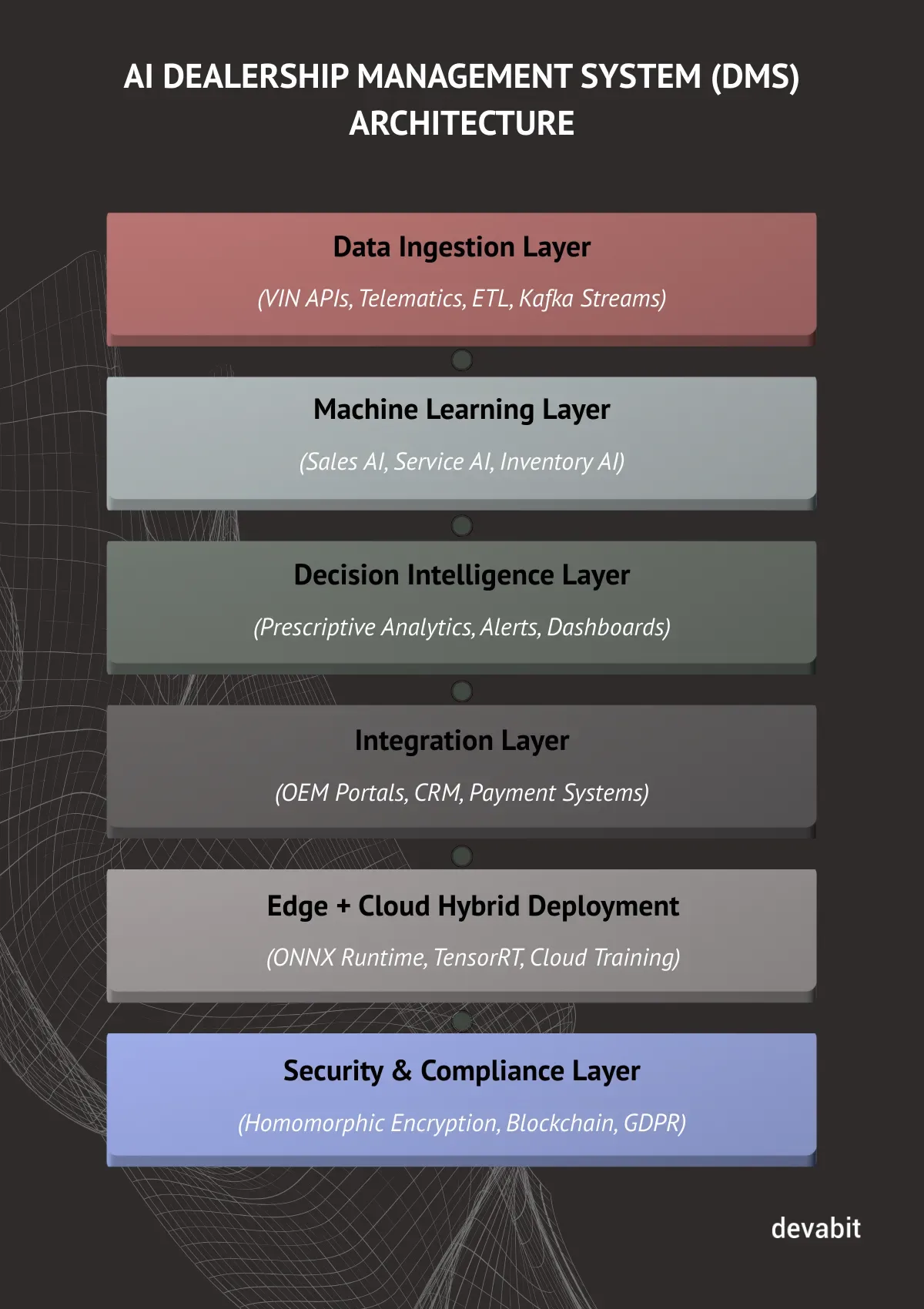
2) AI Advanced Driver-Assistance Systems (ADAS)
Returning to the basics, what are AI advanced driver-assistance systems (ADAS)? AI-powered ADAS refers to specific sensor-driven and algorithm-enhanced driver assistance systems. AI ADAS are powered by ML, computer vision, and sensor fusion. AI ADAS are aimed at:
- detecting external environment conditions and hazards;
- interpreting data collected from object detection sensors, cameras, ultrasonic sensors, LiDAR, Radar, and GNSS & IMU;
- reacting to the driving environment in real time;
- enabling complete autonomous operation (SAE Levels 0–5).

What is the difference between standard ADAS and AI ADAS?
In general, traditional ADAS rely on rule-based algorithms and classical computer vision, such as HOG and Haar cascades. AI ADAS, in turn, utilizes deep neural networks like CNNs, RNNs, and transformers to perform perception tasks. Moreover, traditional ADAS processes sensor inputs in isolation before combining them, while AI-powered solutions provide end-to-end sensor fusion, feeding real-time raw data from multiple sources into a single AI model.
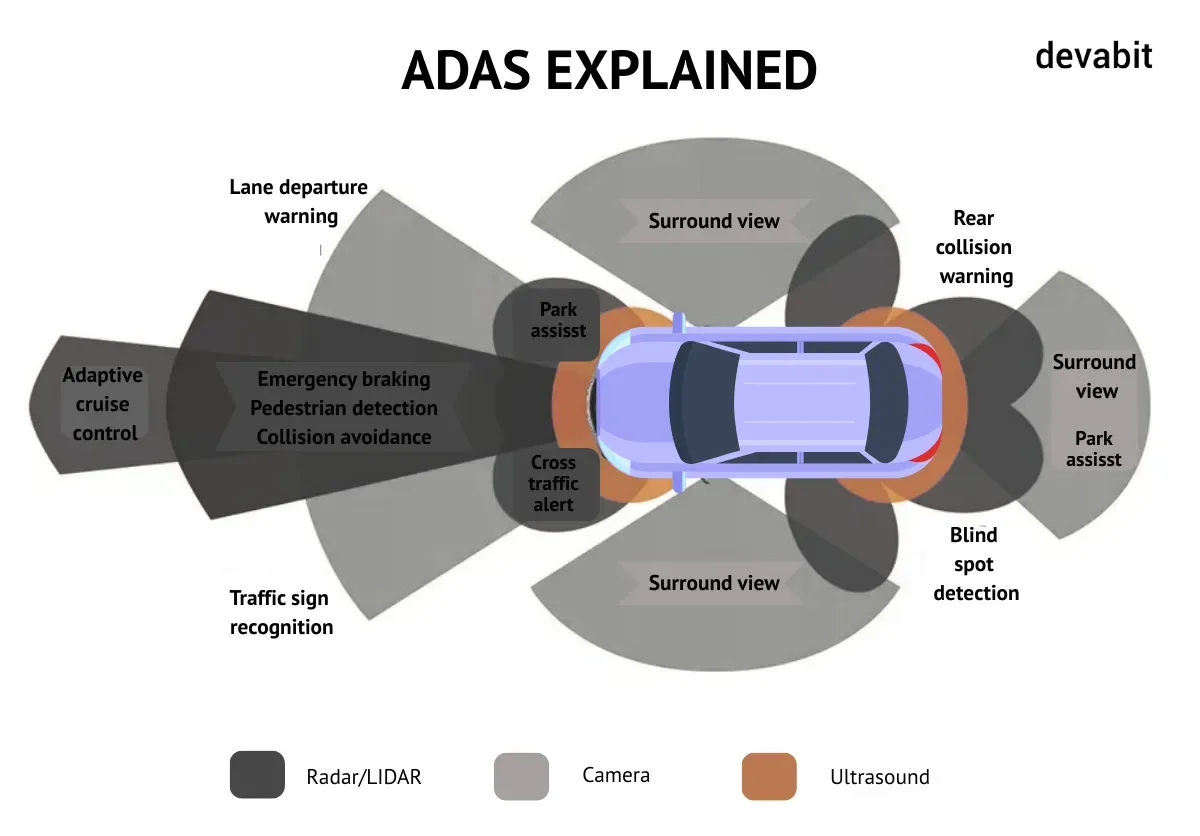
It is challenging to imagine a perfect AI Advanced Driver-Assistance System without a touch of the automotive Machine Learning algorithms. In 2026, not a single vehicle reaches the roads without a thorough ML system training, proper testing in real-life conditions, and all possible passenger safety improvements.
And the potential of the automotive machine learning never ends with road safety, but rather expands to the borders of predictive maintenance, autonomous perception, and smart vehicle manufacturing. And in case you would like to find out what automotive machine learning is, how devabit helps enterprises implement ML into their automotive solutions, and how exactly ML algorithms work, check this out!
Additionally, AI ADAS brings significant improvements to the following aspects:
- Autonomous Emergency Braking (AEB);
- Adaptive Cruise Control (traffic pattern prediction feature);
- Driver Monitoring Systems (gaze tracking feature);
- Parking Assistance (3D mapping), etc.
3) Vehicle-to-Vehicle (V2V) and Vehicle-to-Infrastructure (V2I) Communication
Let's get straight to the point: what do vehicle-to-vehicle (V2V) and vehicle-to-infrastructure (V2I) communication mean? In short, vehicle-to-vehicle communication (V2V) is a direct wireless communication paradigm between several vehicles. To enable V2V communication, every vehicle must be linked to the traffic network and other vehicles. V2V communication is aimed at:
- exchanging vehicle safety and mobility data in real time (no dependence on cellular/cloud infrastructure);
- collision avoidance;
- CACC;
- platooning, etc.
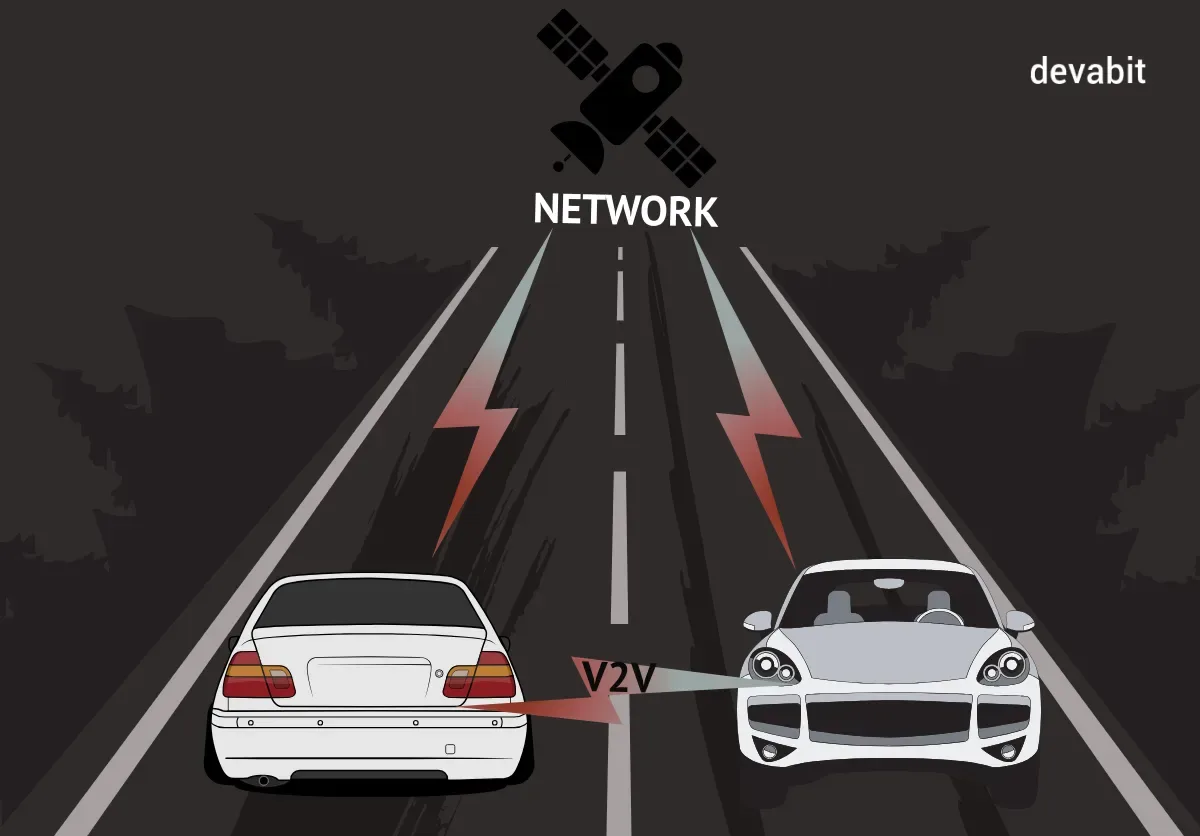
Vehicle-to-infrastructure (V2I) communication, in turn, means a roadside Unit (RSU) communication paradigm between a particular vehicle and roadside infrastructure. To enable V2V communication, every vehicle must be linked to the cellular station and roadside units. The main objectives of V2I communication are as follows:
- exchanging traffic signal priority data;
- tolling;
- generating real-time hazard alerts;
- reporting the exact timing of the traffic light change;
- navigating drivers to available parking spaces to avoid crowds, etc.
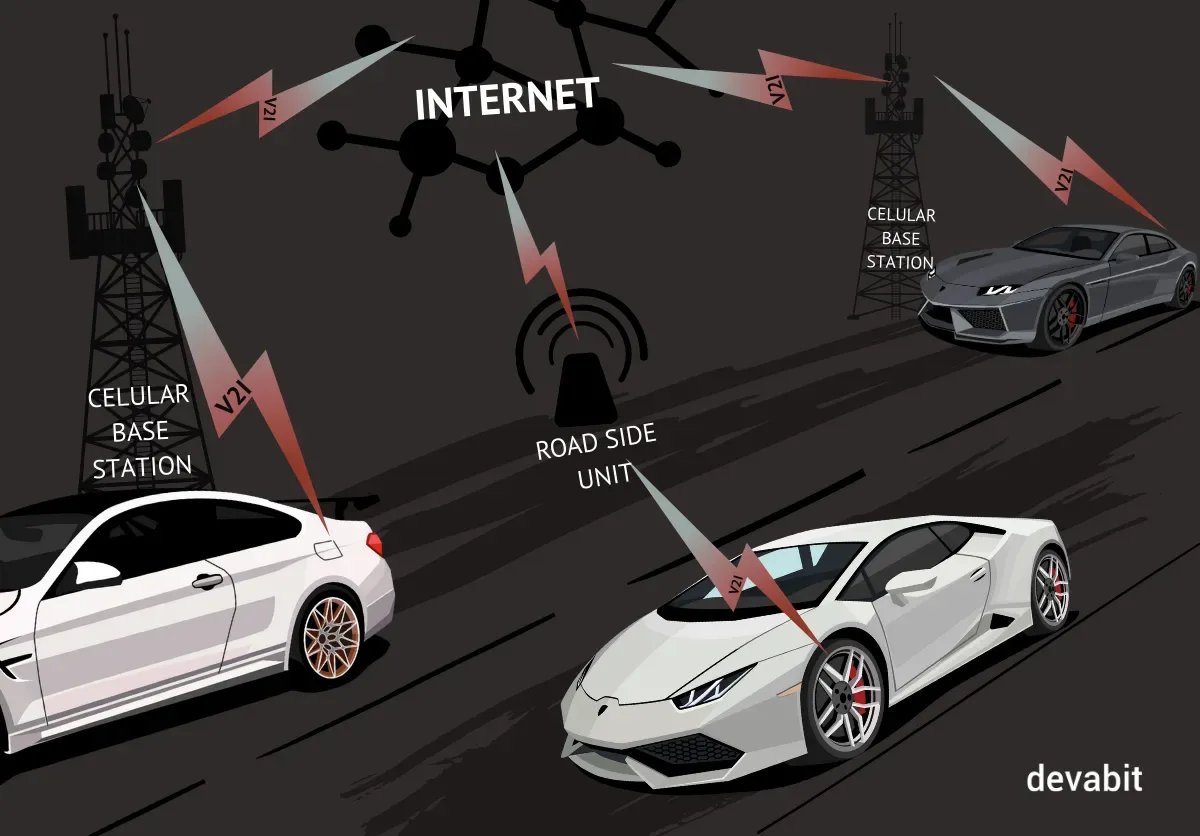
The Use of AI in Automotive Industry: Vehicle Maintenance App Development
Since the use of AI in automotive industry is closely related to vehicle maintenance app development, AI-empowered vehicle maintenance solutions are rapidly evolving from convenience features into core pillars of automotive strategy. Here, the use of AI in automotive industry can be perceived through the prism of predictive analytics, real-time sensor intelligence, and integrated service ecosystems that power these types of apps. Over and above that, the use of in automotive industry (and vehicle maintenance app development accordingly) dramatically redefines the way drivers perceive car ownership, transforming maintenance from a tiring duty into a seamless, often invisible process with excellent outcomes. Due to the widespread use of AI in automotive industry, the real challenge for dedicated engineering teams is no longer whether AI can be applied, but how deeply it can be integrated into the very fabric of the automotive experience.

Why Entrust AI-Powered Automotive Software Development to Devabit?
Volvo, Porsche, and Scania, to mention just a few — our solutions are used by multiple globally recognized leaders in the automotive industry. Turning vehicles into intelligent digital companions, we help automotive suppliers hit their targets faster. Our team enhances the experiences automotive providers create for their customers worldwide. We empower the traditional automotive industry with technology innovation, accelerating your path to mobility disruption. Leveraging the mesh of agile methodology and innovation-driven approach to software development, we created bespoke automotive solutions utilized by Cetrez, Volkswagen, and Aptera.
From expert consulting to scalable cloud solutions and robust engineering, we deliver end-to-end automotive development services:
- Connected Vehicle Technology
- Automotive Cloud Solutions
- ML, AI, and Computer Vision
- Enterprise Mobility Solutions
Besides, our automotive expertise also covers automotive data management capabilities like:
- DMS Integration & Optimization
- Predictive Maintenance Models
- Dealer & Service Center Reporting Tools
- Centralized Automotive Data Lakes

The Use of AI Across Other Industries
Automation, speed, and clarity, to name a few, trendy AI innovations bring multifaceted benefits into various industries, ranging from manufacturing and logistics to 3D modeling and education. Since AI has become accessible to a broader audience, both small businesses and large enterprises are leveraging its powerful capabilities. Let us take a quick look at how industries take advantage of it:
AI & 3D Modeling
In 3D modeling, AI makes a huge difference. How? Well, it significantly speeds up what used to be slow and eliminates manual work. As a result, 3D artists and designers can focus on creativity instead of repetitive tasks like retopology or UV unwrapping. Whether in game development or animation, AI has gained momentum across various aspects of 3D modeling.
AI & Healthcare
In recent years, AI is transforming the healthcare domain by assisting doctors with diagnosis, treatment planning, and patient monitoring. For instance, ML models are widely utilized for analyzing medical images to detect diseases like cancer. Beyond that, AI powers wearable devices and apps that track vital signs, encouraging healthy habits across modern society.
AI & Education
Speaking of education, AI contributes to adaptiveness and personalization. Teachers use AI tools to automate grading, generate exercises, and analyze class performance. The result? They have more time for direct communication and support, which is especially critical in our digital age. Meanwhile, students benefit from AI-powered language tools, study assistants, and various accessibility features empowered by XAI.
Quick Summary on the Use of AI in Automotive Industry
In the modern era of advanced computer processing and applications, the use of AI in automotive industry is constantly emulating human cognition spans, from daily tasks to complex driving and repair decisions. Considering the top 3 uses of AI in automotive industry (AI DMS, AI ADAS, and V2V & V2I communication), it is clear that the impact of AI is huge, and the AI automotive market growth projection is tremendous. During the following decade, we will likely witness multiple automotive security and safety advancements powered by the integration of cutting-edge electronics, internet connectivity, and advanced AI algorithms.
Want to explore more about the use of AI in automotive industry? Read our latest blog posts to get more insights on the use of AI in automotive industry keep pace with emerging technology trends.
Recent Publications
Don't miss out! Click here to stay in touch.
Discover More AI Content

Relevant Articles View all categories
View all categories CONNECT WITH US WE’RE READY
TO TALK OPPORTUNITIES
THANK YOU! WE RECEIVED YOUR MESSAGE.
Sorry
something went wrong



